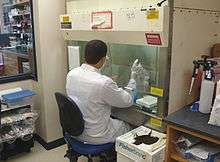Leishmaniasis vaccine
A Leishmaniasis vaccine is a vaccine which would prevent leishmaniasis. As of 2017, no vaccine for humans was available.[1][2] Currently some effective leishmaniasis vaccines for dogs exist.[3]

The parasite which causes leishmaniasis is Leishmania, which is a Trypanosomatida. The disease spreads from sandflies. Animals such as dogs can be a vector for having the parasite, spreading it to sandflies, and from sandflies to humans. A vaccination strategy to control or eliminate Leishmaniasis might include developing a vaccine for humans and other vaccines for animals.
Scientists wish for a vaccine and there is vaccine research.[4] There is also consideration that public health practices can control or eliminate leishmaniasis without a vaccine.[4]
Leishmanization
People who recover from leishmaniasis gain immunity from reinfection.[5] "Leishmanization" is the practice of inoculation with live Leishmania to induce mild cutaneous leishmaniasis (CL) to prevent future dangerous infection.[5][6] Some Bedouin and Kurdish cultures practiced leishmanization as traditional medicine.[7][8] There are historic accounts and decades of medical research describing the efficacy of this.[7]
Traditional knowledge about leishmanization has informed the development of a leishmaniasis vaccine.[7]
Vaccine development
A 2015 paper claimed that the development and use of a vaccine would be the best way to eliminate leishmaniasis from South Asia.[9] Attempts to create a vaccine with live, inactivated or attenuated Leishmania have failed.[10] Attempts to create a peptide, DNA, or protein vaccine have shown efficacy in animal vaccine models but not effective in humans.[10] There are a series of challenges with explanations in molecular biology which explain the difficulty of vaccine development.[10]
Vaccine development is difficult because that the parasites live in humans, sandflies, and in animals, so a vaccine in humans alone would not eliminate the bacteria in insects and animals.[11] There is a challenge in interpreting the data in animal models to apply to humans.[12] Another challenge is effectively transferring knowledge from laboratory settings to field practice.[12] There is also a basic lack of scientific understanding of how an antiparasitic vaccine should generate and maintain immunological memory during parasitic infection.[12]
Clinical trials
As of 2016 there are several vaccines in development and three have gone to clinical trials.[1] One clinical trial in Brazil used an inactivated vaccine for human immunotherapy.[1] Another in Uzbekistan used an attenuated vaccine for human immunotherapy.[1] Another in Brazil was vaccination of dogs to prevent those animals from spreading the disease.[1]
The dog vaccines are successful in providing immunity.[3] In 2008, a vaccine for dogs was launched in Brazil, which is known as LeishTech, a recombinant protein based vaccine.[13] In 2011 CaniLeish, a vaccine made with antigens from L. infantum, was licensed in Europe.[6][13] Efforts are on ongoing to develop further vaccines for dogs with one second generation vaccine up for approval in Brazil as of 2017.[2]
History

In the early 1900s scientists learned how to culture the parasite, and work in the 1940s led by Saul Adler led to the practice of leishmanization being widespread in Israel and Russia until the 1980s, when large-scale clinical trials showed that the practice led to long-term skin lesions, exacerbation of psoriasis, and immunosuppression in some people.[7][8] During the Iran–Iraq War over 2 million people in Iran were vaccinated this way.[15][16] As of 2006 such vaccines were still licensed and used in Uzbekistan.[15]
Clinical trials with killed parasites had conflicting results in the 1940s, and work on such vaccines did not resume until the 1970s, when there were promising small clinical trials, and which continued with extensive clinical trials in Ecuador, Brazil, in Iran, through the 1990s.[17]
Preclinical work with genetically-modified live attenuated parasite vaccines was conducted in the 1990s and 2000s, as did work with synthetic peptides, recombinant proteins, glycoproteins and glycolipids from leishmania species, and naked DNA.[17][6] As of 2016, none of these second-generation vaccine candidates had reached the market, and few had been tested in clinical trials.[18]
References
- Srivastava, S; Shankar, P; Mishra, J; Singh, S (12 May 2016). "Possibilities and challenges for developing a successful vaccine for leishmaniasis". Parasites & Vectors. 9 (1): 277. doi:10.1186/s13071-016-1553-y. PMC 4866332. PMID 27175732.
- Ghorbani, M; Farhoudi, R (2018). "Leishmaniasis in humans: drug or vaccine therapy?". Drug Design, Development and Therapy. 12: 25–40. doi:10.2147/DDDT.S146521. PMC 5743117. PMID 29317800.
- Moafi, M; Rezvan, H; Sherkat, R; Taleban, R (2019). "Leishmania Vaccines Entered in Clinical Trials: A Review of Literature". International Journal of Preventive Medicine. 10: 95. doi:10.4103/ijpvm.IJPVM_116_18. PMC 6592111. PMID 31360342.
- Ghorbani, M; Farhoudi, R (2018). "Leishmaniasis in humans: drug or vaccine therapy?". Drug Design, Development and Therapy. 12: 25–40. doi:10.2147/DDDT.S146521. PMID 29317800.
- Mohebali, M; Nadim, A; Khamesipour, A (December 2019). "An overview of leishmanization experience: A successful control measure and a tool to evaluate candidate vaccines". Acta Tropica. 200: 105173. doi:10.1016/j.actatropica.2019.105173. PMID 31525323.
- Dunning, N. (17 February 2009). "Leishmania vaccines: from leishmanization to the era of DNA technology". Bioscience Horizons. 2 (1): 73–82. doi:10.1093/biohorizons/hzp004.
- Handman, E. (1 April 2001). "Leishmaniasis: Current Status of Vaccine Development". Clinical Microbiology Reviews. 14 (2): 229–243. doi:10.1128/CMR.14.2.229-243.2001. PMC 88972. PMID 11292637.
- Palatnik-de-Sousa, CB (25 March 2008). "Vaccines for leishmaniasis in the fore coming 25 years". Vaccine. 26 (14): 1709–24. doi:10.1016/j.vaccine.2008.01.023. PMID 18295939.
- Engwerda, CR; Matlashewski, G (July 2015). "Development of Leishmania vaccines in the era of visceral leishmaniasis elimination". Transactions of the Royal Society of Tropical Medicine and Hygiene. 109 (7): 423–4. doi:10.1093/trstmh/trv039. PMID 26048873.
- Zutshi, S; Kumar, S; Chauhan, P; Bansode, Y; Nair, A; Roy, S; Sarkar, A; Saha, B (18 October 2019). "Anti-Leishmanial Vaccines: Assumptions, Approaches, and Annulments". Vaccines. 7 (4): 156. doi:10.3390/vaccines7040156. PMC 6963565. PMID 31635276.
- Garg, R; Dube, A (March 2006). "Animal models for vaccine studies for visceral leishmaniasis". The Indian Journal of Medical Research. 123 (3): 439–54. PMID 16778322.
- Kedzierski, Lukasz (May 2010). "Leishmaniasis Vaccine: Where are We Today?". Journal of Global Infectious Diseases. 2 (2): 177–85. doi:10.4103/0974-777X.62881. PMC 2889658. PMID 20606974.
- Bowman, Dwight D. (2014). Georgis' Parasitology for Veterinarians (10th ed.). Elsevier Health Sciences. p. 440. ISBN 9781455739882. Archived from the original on 8 September 2017.
- Killick-Kendrick, R. (20 March 2013). "The race to discover the insect vector of kala-azar: a great saga of tropical medicine 1903–1942". Bulletin de la Société de pathologie exotique. 106 (2): 131–137. doi:10.1007/s13149-013-0285-x. PMID 23516011.
- Khamesipour, A; Rafati, S; Davoudi, N; Maboudi, F; Modabber, F (March 2006). "Leishmaniasis vaccine candidates for development: a global overview" (PDF). The Indian Journal of Medical Research. 123 (3): 423–38. PMID 16778321. Archived (PDF) from the original on 8 September 2017.
- Azizi MH, MH; et al. (2016). "History of Leishmaniasis in Iran from 19th Century Onward" (PDF). Arch Iran Med. 19 (2): 153–162. PMID 26838089. Archived (PDF) from the original on 16 January 2017.
- Handman, E (April 2001). "Leishmaniasis: current status of vaccine development". Clinical Microbiology Reviews. 14 (2): 229–43. doi:10.1128/CMR.14.2.229-243.2001. PMC 88972. PMID 11292637.
- Srivastava, S; Shankar, P; Mishra, J; Singh, S (12 May 2016). "Possibilities and challenges for developing a successful vaccine for leishmaniasis". Parasites & Vectors. 9 (1): 277. doi:10.1186/s13071-016-1553-y. PMC 4866332. PMID 27175732.